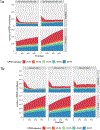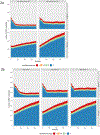Deceased donors as nondirected donors in kidney paired donation
- PMID: 32803856
- PMCID: PMC9436421
- DOI: 10.1111/ajt.16268
Deceased donors as nondirected donors in kidney paired donation
Abstract
As proof of concept, we simulate a revised kidney allocation system that includes deceased donor (DD) kidneys as chain-initiating kidneys (DD-CIK) in a kidney paired donation pool (KPDP), and estimate potential increases in number of transplants. We consider chains of length 2 in which the DD-CIK gives to a candidate in the KPDP, and that candidate's incompatible donor donates to theDD waitlist. In simulations, we vary initial pool size, arrival rates of candidate/donor pairs and (living) nondirected donors (NDDs), and delay time from entry to the KPDP until a candidate is eligible to receive a DD-CIK. Using data on candidate/donor pairs and NDDs from the Alliance for Paired Kidney Donation, and the actual DDs from the Scientific Registry of Transplant Recipients (SRTR) data, simulations extend over 2 years. With an initial pool of 400, respective candidate and NDD arrival rates of 2 per day and 3 per month, and delay times for access to DD-CIK of 6 months or less, including DD-CIKs increases the number of transplants by at least 447 over 2 years, and greatly reduces waiting times of KPDP candidates. Potential effects on waitlist candidates are discussed as are policy and ethical issues.
Keywords: donors and donation: deceased; donors and donation: paired exchange; health services and outcomes research; kidney transplantation/ nephrology; simulation; statistics.
© 2020 The American Society of Transplantation and the American Society of Transplant Surgeons.
Conflict of interest statement
Disclosure
The authors of this manuscript have conflicts of interest to disclose as described by the
Figures




Comment in
-
Deceased donor chains-It is time for debate and consensus.Am J Transplant. 2021 Jan;21(1):5-6. doi: 10.1111/ajt.16362. Epub 2020 Dec 1. Am J Transplant. 2021. PMID: 33080097 No abstract available.
References
-
- Park K, Moon JI, Kim SI, et al. Exchange Donor Program in Kidney Transplantation. Transplantation 1999;67(2):336–338. - PubMed
-
- Rapaport FT. The case for a living emotionally related international kidney donor exchange registry. In: Transplantation Proceedings; 1986. p. 5. - PubMed
-
- Gentry SE, Montgomery RA, Segev DL. Kidney Paired Donation: Fundamentals, Limitations, and Expansions. American Journal of Kidney Diseases 2011;57(1):144–151. - PubMed
-
- Wallis CB, Samy KP, Roth AE, et al. Kidney paired donation. Nephrology Dialysis Transplantation 2011;26(7):2091–2099. - PubMed
-
- Roth AE, Sönmez T, Utku Ünver M. Pairwise kidney exchange. Journal of Economic Theory 2005;125(2):151–188.
Publication types
MeSH terms
Grants and funding
LinkOut - more resources
Full Text Sources
Medical
Research Materials

